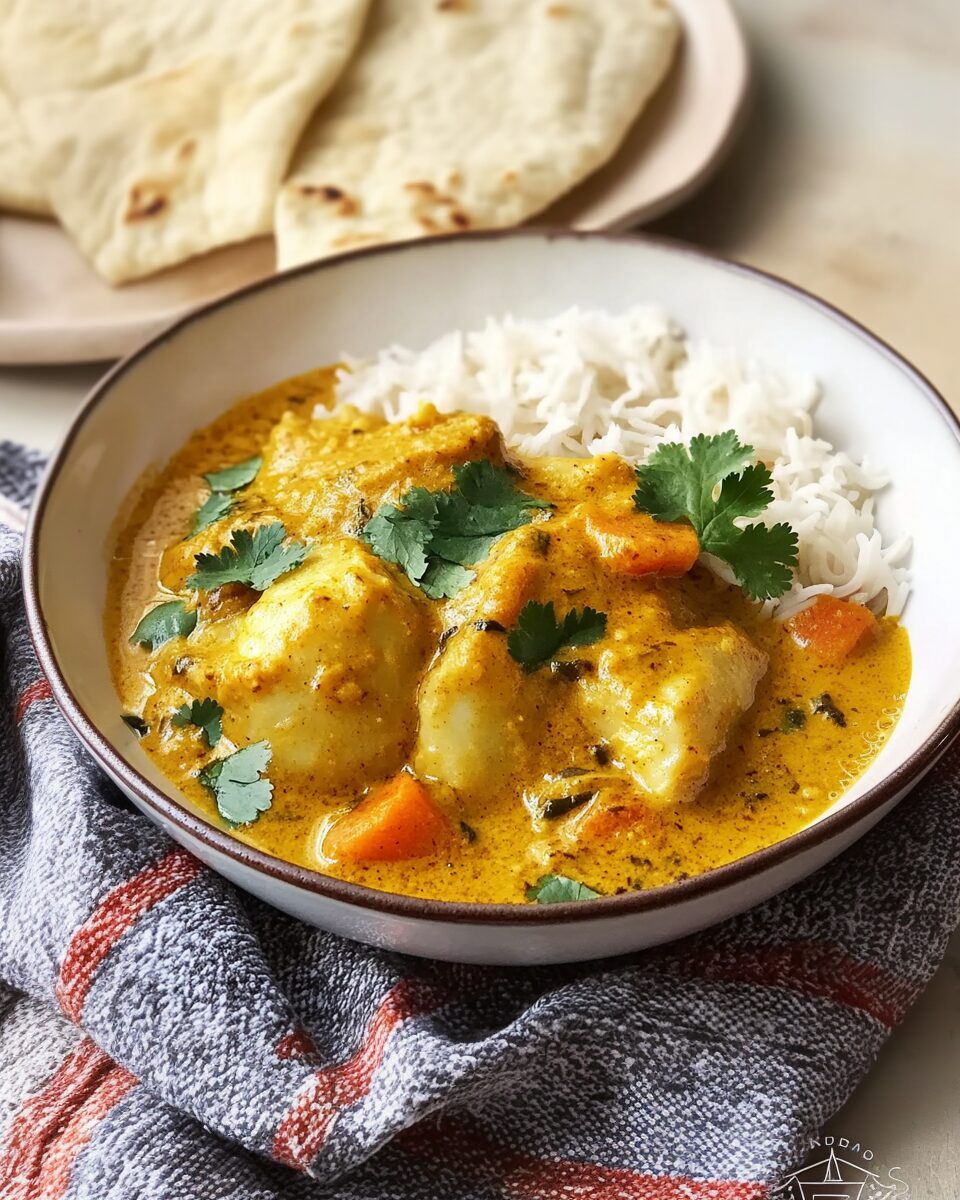A basic curry sauce is a versatile and flavorful base for many dishes. This rich, aromatic sauce can be used with a variety of proteins and vegetables to create a wide range of curry dishes. It’s a staple in Indian cuisine and can be customized with different spices and ingredients based on your taste preferences. Whether you’re serving it with chicken, lamb, or tofu, this curry sauce will elevate any dish with its depth of flavor and warmth.
Full Recipe:
Ingredients
- 2 tablespoons vegetable oil
- 1 large onion, chopped
- 2 cloves garlic, minced
- 1 tablespoon fresh ginger, grated
- 2 tablespoons curry powder
- 1 teaspoon ground cumin
- 1 teaspoon ground coriander
- 1 teaspoon ground turmeric
- 1/2 teaspoon ground cinnamon
- 1/2 teaspoon chili powder (optional)
- 1 can (14 oz) diced tomatoes
- 1 cup vegetable or chicken broth
- 1/2 cup coconut milk or cream
- Salt to taste
Directions
- Heat the vegetable oil in a large pan over medium heat.
- Add the chopped onion and cook until softened, about 5 minutes.
- Add the minced garlic and grated ginger to the pan and cook for another minute.
- Stir in the curry powder, cumin, coriander, turmeric, cinnamon, and chili powder (if using). Cook for 1-2 minutes until the spices are fragrant.
- Pour in the diced tomatoes, broth, and coconut milk. Stir to combine.
- Bring the sauce to a simmer, then reduce the heat and cook for about 20 minutes, stirring occasionally, until the sauce thickens.
- Season with salt to taste.
- Use the sauce immediately with your choice of protein or vegetables, or store it in the fridge for later use.
Nutrients
(Approximate per serving)
- Calories: 120
- Protein: 2g
- Carbohydrates: 10g
- Fat: 9g
- Fiber: 2g
- Sugar: 4g
- Sodium: 350mg
- Calcium: 2% DV
What is Curry Sauce?
Curry sauce is a flavorful, aromatic liquid or paste used in a wide range of dishes. Originating in South Asia, particularly India, the term “curry” refers to a variety of sauces that are often based on a combination of spices, herbs, and sometimes tomatoes or yogurt. Curry sauce is typically made by simmering these ingredients together to create a complex, deeply flavored base. It can range from mild and creamy to bold and spicy, depending on the ingredients used. The base of a curry sauce often includes key spices like cumin, coriander, turmeric, cinnamon, and chili powder, among others, creating a signature aromatic profile.
While curry sauce is most commonly associated with Indian cuisine, it has been adapted and integrated into numerous culinary traditions around the world. In countries such as Thailand, Japan, and the Caribbean, curry sauce plays a central role in many dishes, each with its own variations. Whether paired with meats, seafood, tofu, or vegetables, curry sauce is a universally loved accompaniment that can turn any meal into something special.
The Benefits of Making a Basic Curry Sauce
Making your own curry sauce from scratch offers a wide range of benefits. While store-bought versions are convenient, homemade curry sauce provides the opportunity to control the ingredients, adjust the flavor to your liking, and avoid the preservatives and additives found in pre-packaged options. Let’s dive into some of the key benefits of making a basic curry sauce at home:
-
Customization of Flavors
When making your own curry sauce, you have complete control over the spices and seasonings. You can adjust the level of heat by adding more or less chili powder or opt for milder spices to suit your preference. Additionally, you can experiment with different ingredients like coconut milk, yogurt, or even tamarind paste to create the exact flavor profile you desire. -
Nutrient-Rich and Healthy
Homemade curry sauce is packed with nutritious ingredients, such as onions, garlic, and ginger, which offer a variety of health benefits. These ingredients are rich in antioxidants, vitamins, and minerals that contribute to overall health and well-being. Garlic and ginger, in particular, have been used for centuries for their anti-inflammatory properties and ability to support digestion. -
No Preservatives or Artificial Additives
By making curry sauce at home, you can avoid the preservatives, artificial colors, and flavor enhancers often found in store-bought versions. Using fresh, natural ingredients ensures a healthier dish that is free from unwanted chemicals, making it a cleaner choice for you and your family. -
Versatility and Adaptability
A basic curry sauce is incredibly versatile. It can be made in large batches and used with various proteins, such as chicken, lamb, fish, or tofu, making it suitable for any dietary preference. Additionally, you can modify the sauce to create different variations, such as a coconut curry, tomato-based curry, or a creamy, dairy-free option. This flexibility makes it a perfect go-to recipe for quick weeknight meals, meal prep, or special occasions.
Common Ingredients in a Basic Curry Sauce
A basic curry sauce typically starts with a combination of aromatic vegetables and spices. The key to a rich and flavorful sauce lies in the careful layering of these ingredients. Here are some of the most common ingredients you’ll find in a basic curry sauce recipe:
-
Onions
Onions form the base of many curry sauces and provide a natural sweetness and depth of flavor when cooked slowly. They help build the foundation of the sauce and pair perfectly with the spices used in curry dishes. -
Garlic and Ginger
Garlic and ginger are essential components in most curry sauces. Garlic adds a pungent, savory note, while ginger contributes a spicy, slightly sweet warmth. Together, they provide a balanced base of flavor and enhance the overall taste of the dish. -
Spices
The combination of spices is what defines the flavor of a curry sauce. Commonly used spices include cumin, coriander, turmeric, cinnamon, and chili powder. Each spice contributes a unique taste, and when blended together, they create a harmonious, aromatic sauce. -
Tomatoes
Tomatoes are a key ingredient in many curry sauces, as they provide a rich, slightly tangy base that helps balance out the spiciness of the curry. Some curry sauces rely heavily on tomatoes, while others use them more sparingly as a background flavor. -
Coconut Milk or Cream
Coconut milk adds a creamy, rich texture to curry sauces, making them smooth and luxurious. It also lends a slight sweetness that balances the heat from the spices. For a thicker, creamier sauce, coconut cream can be used instead. -
Broth
The choice of broth—vegetable, chicken, or beef—plays a significant role in the flavor of the curry sauce. Broth adds depth and richness to the sauce, helping to create a savory, well-rounded base.
Tips for Making the Perfect Curry Sauce
-
Layer the Flavors
To create a well-balanced curry sauce, it’s important to layer the flavors by cooking the spices in oil first, allowing them to release their essential oils and fragrance. This step enhances the flavor and ensures that the spices are fully integrated into the sauce. -
Use Fresh Spices
Freshly ground spices will always provide a more intense and aromatic flavor than pre-ground spices. If possible, buy whole spices and grind them yourself to unlock their full potential. -
Simmer for Depth
Allow your curry sauce to simmer gently for at least 20 minutes. This gives the ingredients time to meld together, resulting in a rich, flavorful sauce. The longer you let it simmer, the more the flavors will develop. -
Adjust for Heat
If you prefer a spicier curry, don’t hesitate to increase the amount of chili powder or add fresh chilies. On the other hand, if you prefer a milder curry, reduce the heat by omitting or minimizing the amount of chili powder used. -
Add Sweetness for Balance
Balancing the heat with a touch of sweetness can enhance the overall flavor of the curry sauce. A little sugar, honey, or even a dash of maple syrup can help mellow the spiciness, creating a more harmonious flavor profile.
Creative Uses for Basic Curry Sauce
Once you’ve mastered a basic curry sauce, there are countless ways to use it in your cooking. Here are just a few creative ways to incorporate this sauce into your meals:
-
Chicken Curry
One of the most classic uses for curry sauce is with chicken. Simply cook the chicken pieces in the sauce, allowing the flavors to meld together. Serve over rice or with naan for a satisfying meal. -
Vegetable Curry
Curry sauce works wonderfully with a variety of vegetables, including potatoes, cauliflower, carrots, and peas. This is a great option for vegetarians and vegans who are looking for a hearty, flavorful dish. -
Lamb Curry
Lamb and curry sauce are a match made in heaven. The rich flavor of lamb pairs beautifully with the aromatic spices in the sauce, creating a dish that is both savory and indulgent. -
Seafood Curry
Shrimp, fish, and other seafood also go well with curry sauce. The lightness of seafood combined with the richness of the sauce creates a balanced and satisfying dish. -
Curry Pasta or Stir Fry
For an unconventional twist, use curry sauce as a base for pasta or stir fry. The sauce pairs especially well with noodles, creating a fusion of flavors that is sure to please.
Conclusion
A basic curry sauce is a versatile and essential recipe that can elevate any dish. Whether you’re using it for a quick weeknight dinner or a special meal for guests, this flavorful sauce is sure to impress. By experimenting with different spices, ingredients, and variations, you can create a curry sauce that is uniquely your own. The possibilities are endless, making it a must-have recipe in any kitchen.






